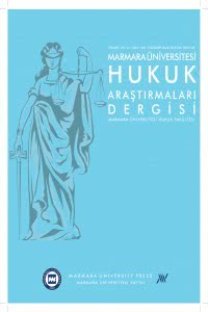Discrimination in the european union: A problem aimed to be resolved or just an instrument to serve the economic targets?
Avrupa birliği’nde ayrımcılık: Çözümlenmesi hedeflenen bir problem mi yoksa sadece ekonomik amaçlara ulaşmada kullanılan bir araç mı?
___
- BOOKS
- ARNULL, Anthony/ WYATT, Derrick, Wyatt and Dashwood’s European Union Law , London:Sweet & Max-well,, 2006.
- BELL, Mark, Anti Discrimination Law and the European Union, Oxford: Oxford University Press, 2002.
- BOZKURT,Enver/ ÖZCAN, Mehmet / KÖKTAŞ, Arif, Avrupa Birliği Hukuku, 4th edn., Ankara, 2008.
- BURROWS, F., Free Movement in European Community Law, Oxford:Clarendon Press, 1987.
- BIRKINSHAW, Patrick, European Union Legal Order After Lisbon, North Canada,USA:Kluwer Law International, 2010.
- CRAIG, Paul, The Lisbon Treaty:Law,Politics and the Treaty Reform, Oxford: Oxford University Press, 2010.
- DE BÚRCA, Grainne, The Role of Equality in EC Law, London: Sweet & Maxwell, 1997.
- DE BÚRCA, Grainne, The Principle of Equal Treatment in EC Law, London: Sweet & Maxwell, 1997.
- EHLERS, Dirk/ BECKER, Ulrich, European Fundamental Rights and Freedoms, Berlin: Walter de Gruyter, 2007.
- HARTLEY, Trevor C., European Union Law in a Global Context: Text, Cases and Materials, Cambridge: Cambridge University Press, 2004.
- KARLUK, Rıdvan, ‘‘Avrupa Birliği’nde Dört Temel Özgürlük’’, in Avrupa Birliği Hukuku ve Avrupa Kurumları, Ankara:Türkiye Barolar Birliği Yayınları, September 2006.
- SARGEANT, Malcolm, Discrimination on Grounds of Nationality, Edinburgh, UK: Pearson Longman, 2004.
- SHAW Jo, ‘‘The Problem of Membership in European Union Citizenship’’ in Zenon BANKOSKI-Andrew SCOTT (Eds.), The European Union and its Order: the Legal Theory of European Integration, UK:Wiley-Blackwell, 2000, pp.65-91.
- SUNDBERG-WEITMAN, Brita, Discrimination on Grounds of Nationality, Free Movement of Workers and Freedom of Establishment under the EEC Treaty, Netherlands: North Holland Publishing, 1977.
- TEKİNALP, Ünal /TEKİNALP, Gülören, Avrupa Birliği Hukuku, İstanbul, $2^{nd}$ edn., May 2000.
- VAN BOCKEL, Bas, The ne bis in idem Principle in EU Law, North Canada,USA:Kluwer Law International, 2010.
- WEATHERILL, Stephen, Cases and materials on EU law, Oxford University Press, 2007.
- JOURNAL ARTICLES
- BERNARD, Nicolas, ‘‘Discrimination and Free Movement in EC Law’’, International and Comparative Law Quarterly, Volume 45 (1996), pp. 82- 108.
- CHALMERS, Damian, ‘‘Repackaging the Internal Market- The Ramifications of the Keck Judgment’’, European Law Review, Volume 19 Issue 4 (1994), pp. 385-403.
- COPPEL, Jason/ O’NEILL, Aidan, ‘‘The European Court of Justice; Taking Rights Seriously’’, Legal Studies, Volume 12 (1992), pp.227-239.
- MCMULLAN, Caroline / HEGARTY, Angela / KEOWN, Caroline, ‘‘Hierarchies of Discrimination; the Political, Legal and Social Prioritization of the Equality Agenda in Northern Ireland’’, Equal Opportunities International, Volume 15 (1996), pp.1-26.
- LEGISLATIVE MATERIALS
- The German Code of Social Law (Sozialgesetzbuch II).
- The Clayton Antitrust Act, 15.10.1914, 15 United State Code (USC) 18.
- The Treaty of Amsterdam amending the Treaty on European Union, the Treaties establishing the European Communities and Certain Related Acts , OJ C340, 10.11.1997.
- Council Directive 2000/43/EC, OJ L185, 29.06.2000.
- Council Directive 2000/78/EC, OJ L303/16 of 27.11.2000.
- Treaty establishing the European Coal and Steel Community, OJ-not published, Date of signature: 18.04.1951, Entry into force: 24.07.1952.
- Treaty establishing European Economic Community, OJ- not published, Date of signature: 25.03.1957, Entry into force: 01.01.1958.
- Treaty on European Union, OJ C191, 29.07.1992.
- Consolidated Text of the Treaty establishing the European Community, OJ C224, 31.08.1992.
- Communication from the Commission on Racism, Xenophobia and Anti- Semitism. Proposal for a Council Decision Designating 1997 as European Year Against Racism, European Union Commission Document (COM) (95) 653 final, 13 December 1995.
- Consolidated Text of the Treaty establishing the European Community, OJ C321E, 29.12.2006 (TEC).
- The Treaty of Lisbon (Official Journal of the European Union (OJ) C306, 17.12.2007.
- Charter of Fundamental Rights of the European Union, OJ C83, 30.03.2010. Consolidated Text of the Treaty on European Union, OJ C83, 30.03.2010 (TEU).
- Consolidated Text of the Treaty on the Functioning of the European Union, OJ C83, 30.03.2010 (TFEU).
- CASE LAW
- Case 2/73 Riseria Luigi Geddo v Ente Nazionale Risi [1973] European Court Reports (ECR) 865.
- Case 120/78 Rewe-Zentral AG v. Bundesmonopolverwaltung für Branntwein [1979] ECR 649.
- Case 293/83 Gravier v. City of Liege [1985] ECR.I-593.
- Case 24/86 Blaizot v. University of Liege [1988] ECR.I-3798.
- Joined Cases C-1/90 and C-176/90, Aragonesa de Publicidad Exterior SA and Publivia SAE v. Departamato de Sanidad y Seguridad Social de la Generalitat de Cataluna [1991] ECR I-4151.
- Case C-2/90 Commission v Belgium [1992] ECR I-4431.
- Case C-267/91 and C-268/91 Criminal Proceedings against Bernard Keck and Daniel Mithouard [1993] ECR I-6097.
- Case C-45/93 Commission v. Spain [1994] ECR I-911.
- Case C-85/96 Martínez Sala [1998] ECR I-2691.
- Case C-274/96 Criminal Proceeding Against Horst Otto Bickel and Ulrich Franz [1998] ECR I-7637.
- C-246/89 Commision v.United Kingdom [1991] ECR I-4585, par. 18 and Case C-311/97 Royal Bank of Scotland [1999] ECR I-2651.
- Case C-184/99 Rudy Grzelczyk v. Centre Public d’Aide Sociale d’Ottignes – Louvain-la-Neuve [2001] ECR I-6193.
- Case C-456/02 Trojani v. Centre Public d’aide sociale de Bruxelles [2004] ECR I-7573.
- Case C-209/3 The Queen, on the Application of Dany Bidar v. London Borough of Ealing and Secretary of State for Education and Skills [2005] ECR I- 2119.
- Case C-164/07 James Wood v. Fonds de garentie des victimes des actes de terrorisme et d’autres infractions [2008] ECR I-4143.
- Joined Cases C-22/08 and C-23/08 Athanasios Vatsouras and Josif Koupatantze v. Arbeitsgemeinschaft (ARGE) Nürnberg 900 [2009] ECR I-4585.
- ISSN: 2146-0590
- Yayın Aralığı: 2
- Başlangıç: 1996
- Yayıncı: Marmara Üniversitesi
MÜTESELSİL BORÇLUNUN RÜCU HAKKININ DOĞUMUNDAN ÖNCE BORÇTAN KURTARILMA TALEBİ
CEZA MUHAKEMESİ HUKUKUNDA TUTUKLUNUN SALIVERİLME TALEBİNİN İNCELENME USULÜ
TÜRK CEZA YASASI’NDA İŞARET VE ENGEL KOYMAMA SUÇU (TCK m.178)
İNSAN HAKLARI AVRUPA SÖZLEŞMESİ’NE GÖRE SERBEST SEÇİM HAKKI
İNSAN HAKLARI AVRUPA MAHKEMESİ KARARLARI IŞIĞINDA TUTUKLAMA HUKUKUNA ELEŞTİREL YAKLAŞIM
GÜMRÜK ANTREPOLARI, EŞYANIN TASFİYESİ VE ANTREPO ÜCRETİNDEN SORUMLULUK
HUKUKÇUNUN HUKUK KARŞITI TUTUMUNUN EDEBİ DIŞAVURUMU: DR. FRANZ KAFKA VE “DAVA”SI
